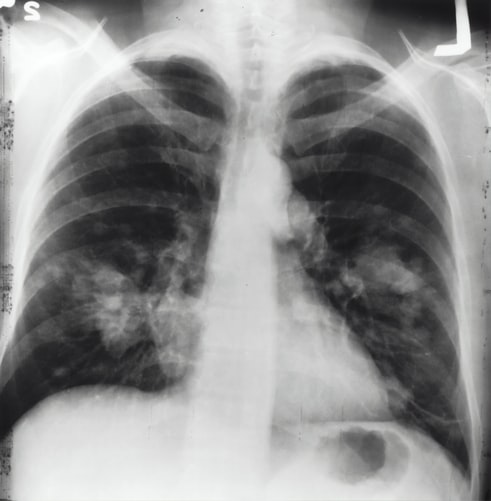Roughly 80% of patients with mesothelioma were previously exposed to asbestos. Malignant mesothelioma develops when asbestos fibers are inhaled into the body and become lodged within the linings of the lungs, abdomen, heart, or testes.
How Can You Get Mesothelioma?
Mesothelioma is caused by inhaling asbestos fibers. Once inhaled, asbestos fibers can migrate to the patient’s lungs and abdomen and become lodged into the mesothelium: a protective membrane that covers internal organs.

Asbestos fibers can cause scarring and inflammation of the cells. This may alter the cell’s DNA structure, causing it to become cancerous. A patient may not experience mesothelioma symptoms until decades after their asbestos exposure.
There are multiple types of mesothelioma which vary depending on the areas of the body asbestos fibers travel to.
Pleural mesothelioma is caused by asbestos fibers that lodge within the pleura, the lining of the lungs.
The other type of mesothelioma is peritoneal mesothelioma. This form of cancer develops when asbestos fibers become embedded within the peritoneum, the lining of the abdominal cavity.
While mesothelioma remained a relatively rare and unknown form of cancer throughout much of modern history, it became more prevalent in the 20th century when asbestos became popular for its heat-resistant qualities. As a result, more industries began using asbestos for everything from insulation and drywall to auto parts and fire-retardant clothing.
Mesothelioma Risk Factors
Individuals who have worked in industries that manufactured or used asbestos-containing products may have a greater risk of developing mesothelioma. This also includes veterans, as asbestos was commonly used by the U.S. military.

Primary Risk Factors
The following factors may increase an individual’s risk of developing mesothelioma:
-
Working in a profession with greater exposure to asbestos, such as construction
-
Working in facilities that contain or manufacture asbestos products
-
Renovating a home or business built with asbestos products
-
Living in an area located near an asbestos mine
-
Living near a site contaminated with asbestos
-
Employment at an asbestos-processing plant
-
Employment at an asbestos mine
-
Service in the U.S. military
Occupational Exposure to Asbestos
The number one risk factor attributed to mesothelioma is occupational exposure to asbestos.
Individuals working in construction or demolition may have a higher risk of developing mesothelioma due to the widespread use of asbestos in home and commercial building construction prior to the 1980s.
To this day, there is still a considerable amount of asbestos in older buildings and homes.
Firefighters may also have an increased risk of asbestos exposure for similar reasons. Whenever fires or other disasters destroy a building that was built with asbestos products, firefighters and other first responders are at risk of inhaling asbestos fibers.
Shipyard or power plant workers may be equally at risk of asbestos exposure due to the historically frequent use of asbestos products in these industries.
Environmental Exposure
Asbestos is a naturally found mineral known for its heat-resistant and fibrous composition. A natural carcinogen, asbestos dust and fibers are incredibly dangerous to humans if inhaled or ingested.
Those who live in areas where naturally occurring asbestos minerals are present, particularly along the west and east coasts of the U.S., could be at risk of inhaling asbestos. It’s important that these minerals are not disturbed, as they may release toxic dust into the air.
Communities may also come into contact with asbestos through contaminated water. This is commonly caused by industrial pollution of local water sources, which may eventually contaminate residential wells and drinking water. The natural evaporation of this polluted water can also result in airborne asbestos fibers.

Airborne asbestos fibers can travel for several miles, endangering residents living in nearby areas.
Gender
Studies have shown that men are more likely to develop mesothelioma than women, although it is still unknown if genetics play a role in this. It is believed that this is primarily attributed to the fact that men are more likely to work in occupations that use or have used asbestos.
Irrespective of gender, patients with mutations in the tumor-suppressor gene BAP1 may also be more likely to develop mesothelioma after asbestos exposure.

Age
Although the average age of patients diagnosed with mesothelioma is 69, there is no correlation between age and the likelihood of developing this form of cancer. Mesothelioma has a long latency period, typically taking anywhere between 20 and 50 years to form after asbestos exposure, which is why it occurs more frequently among older populations.

Lifestyle
While a healthy lifestyle may not necessarily prevent a mesothelioma diagnosis, it is believed that patients who exercise frequently, have a healthy diet, and maintain good sleep habits may experience fewer or less severe side effects from mesothelioma treatment.

Although a healthy lifestyle may not prevent someone from developing mesothelioma, it may improve treatment results and reduce symptoms.
Can Smoking Increase the Risk for Developing Mesothelioma?
There is no direct link between smoking and mesothelioma. If, however, a smoker is exposed to asbestos, they may be at greater risk of developing both lung cancer and mesothelioma.
Smoking tobacco damages the parts of the lungs that help to remove debris and assist in airflow. Without healthy lung function, cellular waste and asbestos can accumulate, resulting in decreased oxygen and damage to the cells. This can eventually cause mesothelioma and other cancers.
Where Are Common Sources of Asbestos Exposure?
Individuals are most likely to come in contact with asbestos at work, although asbestos is also present in the home and in nature.
Construction workers and home renovators are particularly susceptible to asbestos exposure when they work on older buildings, as asbestos was commonly used in insulation, drywall, tiles, and shingles. When disturbed, these materials may release asbestos fibers into the air, endangering anyone nearby. Because of these dangers, asbestos removal is highly regulated. A business that ignores safety rules and regulations may be fined by the government.
How Mesothelioma Develops
Mesothelioma may form when asbestos fibers are inhaled into the body and become lodged within the lining of the lungs or abdomen. Over time, these fibers can damage cellular DNA.
Once asbestos is in the body, it is difficult to rid itself of the fibers because of its fine, shard-like quality. Repeated asbestos exposure may cause more fibers to accumulate within the body, and increase the likelihood that cancer will develop.

When inhaled, asbestos fibers typically travel to the lungs, heart, or abdomen where they will often lodge within the lining of these organs. If cancer develops, these organs will primarily be affected, though mesothelioma can spread to other parts of the body over time.

Preventing Mesothelioma
The most effective way to prevent mesothelioma is following proper safety regulations in the workplace to reduce your exposure to asbestos.
If you believe that you have been exposed to asbestos, even if it was decades ago, you should seek medical attention. Your doctor may recommend tests that can detect if cancer has developed.

 Rae Steinbach
Rae Steinbach